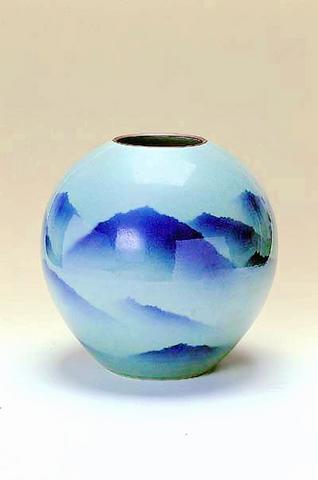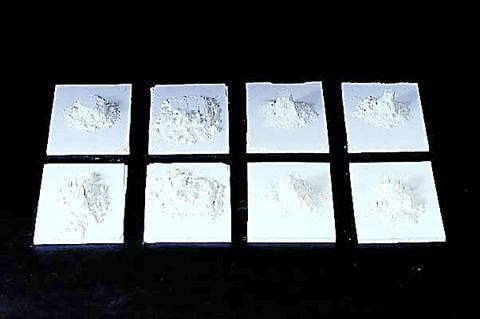If touring Taipei Fine Arts Museum's latest exhibition of ceramic works by foreign artists from the permanent collection sounds strictly like a rainy-day activity, it is. It's not that the exhibit is uninteresting or uninformative, but it's not unlike flipping through a photo album of someone else's family.
That's because the pieces on exhibit -- 81 of them in total -- were mostly donated by international artists when TFAM first opened its doors nearly 20 years ago. Others were donated following a 1995 international ceramics exhibition -- the museum's first -- which featured 266 works by 165 artists. And while each of the pieces represents what the artist considered to be his or her best, TFAM was not at that time in a position to turn down the artists' donations. The result, when laid out on shelves two decades later, is an exhibit curated largely by the artists themselves.

PHOTO COURTESY OF TFAM
TFAM's June Chu (

PHOTO COURTESY OF TFAM
Educational it may be, but as most of the pieces were produced two decades ago, any claim of being "cutting edge" has long since dulled -- while all the pieces are original, you can't escape the feeling that you've seen similar works adorning the shelves of boutiques throughout Taiwan's more touristed townships. For the most part, you have.
One exception is found in Kosho Ito's eight plates of alumina. Ito, who was born to a gold engraver in 1931 and operates a pottery studio with his wife in Kasama, Japan. His White Solid of Alumina series is a mixture of white alumina and ceramic industry standard quartz fired at 12,500℃ then set in a wooden box and fired again until the box was incinerated resulting in the collapse of solid materials to emphasize the natural state of ceramics materials. Think of a southwestern American landscape in white miniature.
It may not sound all that exciting -- and perhaps alone it's not -- but contrasted against a room filled with 80 other pots, plates and who-knows-whats, it begs attention despite having been relegated to the corner. Whereas the other abstract pieces in the exhibit are the products of their creators' imaginations, Ito's plates of alumina differ insofar as he allowed his materials to create their final form.
Another piece that shines is Kutani Koyo's Celadon Jar with Landscape (an interesting aside: the most striking pieces in the exhibit are largely the work of Japanese artists). Koyo's hand-thrown jar is a full shape decorated on the outside with graduated mountain forms in cobalt oxide. Blue porcelain glaze gives the vessel luster and brushed ferrous oxide adds a touch of auburn at the rim of this piece, easily the most stately and elegant in the exhibit.
The large remainder of the exhibit is unfortunately forgettable. For the record, though, Chu says TFAM is now quite a bit pickier about what pieces they accept into their permanent collection.
Ceramic works by foreign artists from the museum's permanent collection will be on display at the Taipei Fine Arts Museum until Aug. 31.

May 18 to May 24 Pastor Yang Hsu’s (楊煦) congregation was shocked upon seeing the land he chose to build his orphanage. It was surrounded by mountains on three sides, and the only way to access it was to cross a river by foot. The soil was poor due to runoff, and large rocks strewn across the plot prevented much from growing. In addition, there was no running water or electricity. But it was all Yang could afford. He and his Indigenous Atayal wife Lin Feng-ying (林鳳英) had already been caring for 24 orphans in their home, and they were in

On May 2, Chinese Nationalist Party (KMT) Chairman Eric Chu (朱立倫), at a meeting in support of Taipei city councilors at party headquarters, compared President William Lai (賴清德) to Hitler. Chu claimed that unlike any other democracy worldwide in history, no other leader was rooting out opposing parties like Lai and the Democratic Progressive Party (DPP). That his statements are wildly inaccurate was not the point. It was a rallying cry, not a history lesson. This was intentional to provoke the international diplomatic community into a response, which was promptly provided. Both the German and Israeli offices issued statements on Facebook

Even by the standards of Ukraine’s International Legion, which comprises volunteers from over 55 countries, Han has an unusual backstory. Born in Taichung, he grew up in Costa Rica — then one of Taiwan’s diplomatic allies — where a relative worked for the embassy. After attending an American international high school in San Jose, Costa Rica’s capital, Han — who prefers to use only his given name for OPSEC (operations security) reasons — moved to the US in his teens. He attended Penn State University before returning to Taiwan to work in the semiconductor industry in Kaohsiung, where he

President William Lai (賴清德) yesterday delivered an address marking the first anniversary of his presidency. In the speech, Lai affirmed Taiwan’s global role in technology, trade and security. He announced economic and national security initiatives, and emphasized democratic values and cross-party cooperation. The following is the full text of his speech: Yesterday, outside of Beida Elementary School in New Taipei City’s Sanxia District (三峽), there was a major traffic accident that, sadly, claimed several lives and resulted in multiple injuries. The Executive Yuan immediately formed a task force, and last night I personally visited the victims in hospital. Central government agencies and the